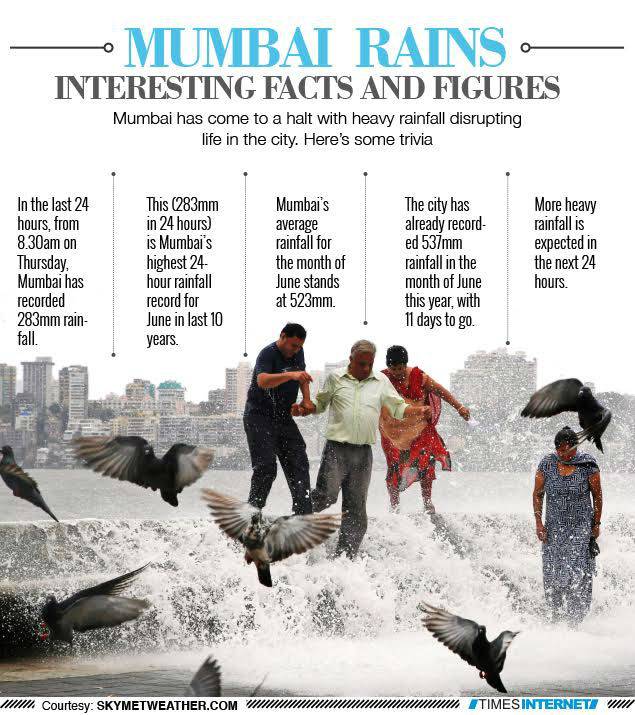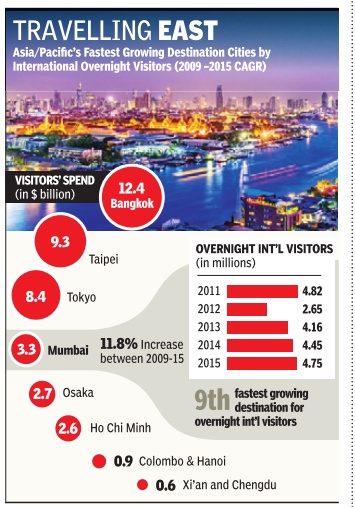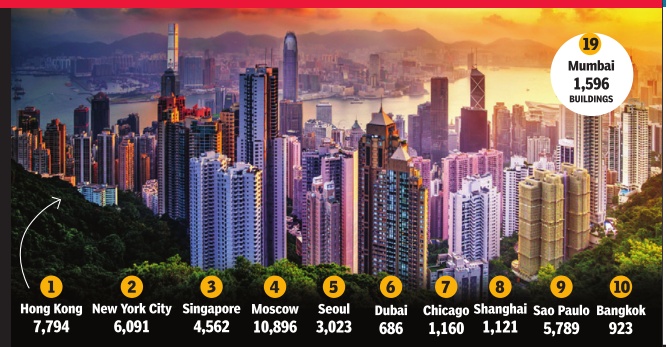Mumbai: Home page/ factfile/ general issues
(→First International Arbitration Centre in India) |
(→Monsoons: Mumbai) |
||
| Line 36: | Line 36: | ||
=Monsoons: Mumbai= | =Monsoons: Mumbai= | ||
[[File: monsoons mumbai.jpg|Some facts: Rainfall in June: Mumbai; Graphic courtesy: [http://timesofindia.indiatimes.com/infographics/Mumbai-rains-Interesting-facts-and-figures/infoshow/47733119.cms ''The Times of India''], June 19, 2015|frame|500px]] | [[File: monsoons mumbai.jpg|Some facts: Rainfall in June: Mumbai; Graphic courtesy: [http://timesofindia.indiatimes.com/infographics/Mumbai-rains-Interesting-facts-and-figures/infoshow/47733119.cms ''The Times of India''], June 19, 2015|frame|500px]] | ||
| + | |||
| + | ==July 2017, third lowest rainfall since 2008== | ||
| + | [http://timesofindia.indiatimes.com/city/mumbai/city-sees-third-lowest-july-rainfall-since-08/articleshow/59869219.cms Richa Pinto, Mumbai sees third lowest July rainfall since 2008, Aug 2, 2017: The Times of India] | ||
| + | |||
| + | |||
| + | '''HIGHLIGHTS''' | ||
| + | |||
| + | The rainfall recorded in June 2017 was 523.2 mm barely crossing its required average of 523.1mm for the month | ||
| + | |||
| + | In July the total rainfall recorded was 869.6mm, which again crossed the average of 799.7mm | ||
| + | |||
| + | In July 2017, the city recorded a rainfall of 869.6mm, the third lowest reading for the month since July 2008. The onset of monsoon over Mumbai this year was declared on June 12, two days after its normal date. The total rainfall recorded by the IMD Santacruz observatory from June 1 to July 31 this year has been 1,392.8mm. The rainfall recorded in June 2017 was 523.2 mm barely crossing its required average of 523.1mm for the month. | ||
| + | In July the total rainfall recorded was 869.6mm, which again crossed the average of 799.7mm. The IMD Santacruz weather station's reading is considered to be indicative of Mumbai. Weather officials said that such variability will always be there in the rainfall reading. "The gap increases when there is a reduction in rain received in the city," said K S Hosalikar, deputy general, western region, IMD. It is also pertinent to note that July 17 this year was the city's wettest July day in three years, which led the city to meet it average target for the month. | ||
| + | |||
| + | It is observed that the city receives heavy rainfall due to a system in the Arabian sea or Bay of Bengal. | ||
| + | The last few days of subdued rainfall in Marathwada has farmers worried over the fate of their sown crops. | ||
| + | |||
| + | Marathwada, which falls in the rain shadow area, is currently the only subdivision in central India that has slipped into the 'deficient' seasonal rainfall category. Since June 1, it has reported a 21% shortfall in rainfall.(Inputs from Neha Madaan). | ||
=Overnight international visitors: 2009-2015= | =Overnight international visitors: 2009-2015= | ||
Revision as of 17:22, 3 August 2017
This is a collection of articles archived for the excellence of their content. |
Contents |
Chaupatty
Mar 19 2015
Prafulla Marpakwar & Nergish Sunavala
Girgaum Chowpatty, Mumbai's oldest and most famous beach, will soon be called Swaraj Bhoomi.
The BJP-led state government on Wednesday decided to rename the iconic stretch in south Mumbai in keeping with a demand made by the Lokmanya Tilak Gaurav Samiti.
The Samiti had demanded that the spot at Chowpatty where Lokmanya Tilak was cremated, and where a garden stands now, should be called Swaraj Bhoomi. However, the government took it a giant step forward.
There was confusion for some time on Wednesday on whether the garden alone or the entire stretch had been renamed, but a bureaucrat in the chief minister's office confirmed to TOI that not just the garden but the area itself would bear the new name. Though the name Chowpatty has become ge neric in Mumbai over the years, given that Dadar and Juhu beaches too bear the same appendage, it is actually a proper name.
Locals were critical of the name change. Nandita Jhaveri, who has lived near Chowpatty for over 30 years, said, “Before I was born it was called Chowpatty and there is no reason why it should be called something else.“
The Girgaum beach was called `Chau-pati' because of `four channels' of water that existed there. It remains one of the best spots from which to see the sunset in Mumbai.
When, a year ago, the Samiti first made its demand to the then Congress-NCP government, it received no response. CM Devendra Fadnavis, who was then state BJP chief, had strongly supported its proposal. On Wednesday, he confirmed to TOI that the government had “accepted the proposal.
HISTORY BEHIND ITS GEOGRAPHY
The name Chowpatty comes from “chau pati“ or four channels.According to the 1917 book Bombay Place Names and Street Names, this describes the inroads made by the tide before the western foreshore was reclaimed. In 1865, the summit of Malabar Hill was excavated to provide filling for the Chaupati reclamation and the sea-face road which runs to Malabar Hill. The name is similar to Satpaty, a village in the Mahim taluka of Thane district, which is approached by a channel containing seven streams
Monsoons: Mumbai

July 2017, third lowest rainfall since 2008
Richa Pinto, Mumbai sees third lowest July rainfall since 2008, Aug 2, 2017: The Times of India
HIGHLIGHTS
The rainfall recorded in June 2017 was 523.2 mm barely crossing its required average of 523.1mm for the month
In July the total rainfall recorded was 869.6mm, which again crossed the average of 799.7mm
In July 2017, the city recorded a rainfall of 869.6mm, the third lowest reading for the month since July 2008. The onset of monsoon over Mumbai this year was declared on June 12, two days after its normal date. The total rainfall recorded by the IMD Santacruz observatory from June 1 to July 31 this year has been 1,392.8mm. The rainfall recorded in June 2017 was 523.2 mm barely crossing its required average of 523.1mm for the month. In July the total rainfall recorded was 869.6mm, which again crossed the average of 799.7mm. The IMD Santacruz weather station's reading is considered to be indicative of Mumbai. Weather officials said that such variability will always be there in the rainfall reading. "The gap increases when there is a reduction in rain received in the city," said K S Hosalikar, deputy general, western region, IMD. It is also pertinent to note that July 17 this year was the city's wettest July day in three years, which led the city to meet it average target for the month.
It is observed that the city receives heavy rainfall due to a system in the Arabian sea or Bay of Bengal. The last few days of subdued rainfall in Marathwada has farmers worried over the fate of their sown crops.
Marathwada, which falls in the rain shadow area, is currently the only subdivision in central India that has slipped into the 'deficient' seasonal rainfall category. Since June 1, it has reported a 21% shortfall in rainfall.(Inputs from Neha Madaan).
Overnight international visitors: 2009-2015

The Times of India, Jun 04 2015
Kounteya Sinha
City set for record foreign overnight visitors
Mumbai raked in a whopping $3.3 billion from visitors who stayed overnight in the city in 2015, making it the fourth most lucrative market in the Asia-Pacific for overseas spenders. Bangkok in Thailand saw the highest visitor spend in the region in 2015 -$12.4 billion followed by Taipei ($9.3 billion) and Tokyo ($8.4 billion).
As many as 4.75 million people have till now stayed overnight in Mumbai in 2015 -all set to record the highest number of international visitors who stopped by in the city in the past five years with almost half a year to go before year-end. Mumbai in 2011 recorded the highest number of overnight international visitors -4.82 million.
The growing number of tourists stopping over in Mumbai has made the city the only Indian entry in the Asia-Pacific to figure in the top 10 fast growing cities by international overnight visitors. It is now the ninth fastest growing city by international overnight visitors (2009-2015). In 2014, Mumbai saw 4.45 million international overnight visitors while in 2013, it stood at 4.16 million.
With data going back to 2009, the Global Destination Cities Index charts how 132 of the most important cities in the world are connected through air travel -how many international visitors arrive at each of these 132 cities from the other cities and how much these visitors spend during their visit.
The only year Mumbai saw a major dip in overnight tourists over the past five years was in 2012 when it recorded just 2.65 million international overnight visitors. In almost every other year, the city has had over four million such tourists.
In 2015, it is expected that 382.9 million trips will be made by international visitors by air between the 132 cities covered by the Index, spending a total of $360 billion during their visits.
According to the index, London is the world's topranked destination city with 18.82 million international visitors expected in 2015, slightly ahead of secondranked Bangkok with 18.24 million. London has topped the index in five out of seven years, except 2012 and 2013, when Bangkok held the lead position. They are followed by Paris, Dubai, Istanbul, New York, Singapore, Kuala Lumpur, Seoul and Hong Kong in the world top 10.
Colombo in Sri Lanka, interestingly , has emerged the fastest growing market with a 21.1% increase in overnight stays. Chengdu in China's Sichuan province is the second fastest with a 20.7% growth rate.
According to the index, the “prerequisite for any destination city that aspires to attract more international visitors is to increase the capacity of its airports and frequency of flight connections between the airport and the rest of the world“.
Ranking according to number and height of buildings
The Times of India, May 31 2015

An international building database Emporis has come up with a list of top skylines of the world.Hong Kong leads the table, followed by New York City.Mumbai, with 1,596 buildings, is in the 19th position.The ranking is based on the number and height of buildings in major cities
Victorias
The Times of India, Jun 09 2015
Shibu Thomas
Joyride illegal; horses treated cruelly: Court
In a victory for ani mal rights activists, the Bombay high court ruled that horse-drawn car riages -locally called `Victo rias' -used for joyride along the seaside were “illegal“, and set a June 2016 deadline to phase them out. Hearing a PIL filed by Animals and Birds Charitable Trust, an NGO, a bench of Jus ices Abhay Oka and Anil Menon ordered the Brihanmumbai Municipal Corporation BMC) to shut down stables housing the horses and ponies in the city within a year.
“The activity of running Victorias driven by horses in Mumbai for joyride is completely illegal and is required to be stopped,“ said the judges, adding it also amounted to violating the Prevention of Cruelty to Animals Act.
“The activity of horse-driven carriages only for joyrides solely for human pleasure is an avoidable human activity,“ they said.
The court's decision to ban the carriages, which now ply only on Marine Drive, Nariman Point and Gateway of India, was also based on existing licensing rules, the fact that they are a safety risk and a traffic hazard on crowded Mumbai roads.
While such carriages can operate in other cities when used for public conveyance, the HC asked the state to taken action whenever they are used for joyrides. The authorities have also been asked to act against those treating the horses cruelly .
At the same time, the court has asked the state government to frame a plan for the rehabilitation of the carriage owners --Victorias are a source of livelihood to about 700 families -and the horses.
Victorias have been a feature on Mumbai streets for decades. In 1973, when the government brought in a new rule to deny renewal of licenses for the horse-driven carriages, there were around 800 Victorias in the city. By 2011, when the PIL was filed seeking a ban, there were around 130 left.
The Victorias were given licences un der a 1920 law for being used as a public conveyance. The HC said the Victorias were not presently plying for either con veyance of passengers or goods and their use was limited to joyrides.
The court also extensively relied on affidavits filed by Mumbai traffic police, who classified these carriages as a safety risk and not in public interest. “The horsedrawn carriages now serve to be an encumbrance and a great hazard on the already crowded streets of Mumbai,“ said the affidavit.
The court took into consideration the traffic police's report on the way the horses were treated -unfit horses were made to draw carriages that were overloaded with passengers and they were made to ply on concrete and tar roads without proper horse shoes.
“The horses which are used to propel the Victorias suffer from diseases and are unable to manoeuvre themselves in heavy traffic, leading to accidents,“ one of the affidavits said.
2016
First International Arbitration Centre in India
The Indian Express, October 9, 2016
The country’s first International Arbitration Centre was inaugurated in Mumbai in October 2016.
The setting up of the Mumbai Centre for International Arbitration (MCIA) — which can resolve disputes between different companies or individuals — can be a step towards establishing the city as an international financial centre.
Before this, most of the global business disputes involving Indians landed in the Singapore or the London arbitration centres. The total outflow of funds to resolve such cases, complete with logistics and other related expenditure, works out to around $ 5 billion, sources said. A centre in India can significantly bring down this cost.
Apart from the infrastructure, the MCIA is backed by robust policies both at the Centre and the state, the chief minister said. Maharashtra is the first state in India to have a comprehensive arbitration policy. While dwelling on the significance of a quick disputes-redressal mechanism, Fadnavis said, “A crucial factor to establish ease of doing business and attract foreign direct investments is a healthy arbitration resolving eco-system. In this, time and space are key. A centre in Mumbai will take care of both these factors.” So far, the closest arbitration centre for India was in Singapore.
According to a study conducted by the Singapore International Arbitration Centre, almost 30 per cent of the disputes it hears annually relate to matters involving Indian businesses. Also, the number of disputes it settled between 2001 and 2013-14 shows a ten-fold increase. The MCIA is located on the 20th floor of Express Towers, Nariman Point, and is headed by CEO Madhukeshwar Desai. The 7,000-square feet facility is equipped with hi-tech, secure hearing rooms with simultaneous transcription services. It is co-chaired by Nish Shetty, Head Asia Pacific, Clifford Chance, and Vyapak Desai, partner, Nishith Desai and Associates.
It has on board leading international and domestic arbitration practitioners such as Sir Bernard Rix, Former Lord Justice, English Court of Appeal; David W Rivkin, President, International Bar Association; James Spigelman, former Chief Justice of New South Wales; Michael Pryles, former President of the SIAC Court of Arbitration; John Beechey former President of the ICC International Court of Arbitration; Christoper Lau, Supreme Court Chartered Arbitrator; Nicolas Peacock, partner, Herbert Smith; Justice Surinder Singh Nijjar, former judge of Supreme Court of India; Justice Ferdino Rebello, former chief justice of the Allahabad HC; Cyril Shroff, Managing Partner, Cyril Amarchand Mangaldas; Pallavi Shroff, managing partner, Shardul Amarchand Mangaldas; Vikram Nankani, senior advocate Bombay HC; Promod Nair, Head of Chambers, Arista Chambers; Shreyas Jayasimha, Managing Partner Aarna Law; and Nakul Dewan, advocate, Supreme Court of India. on Saturday.